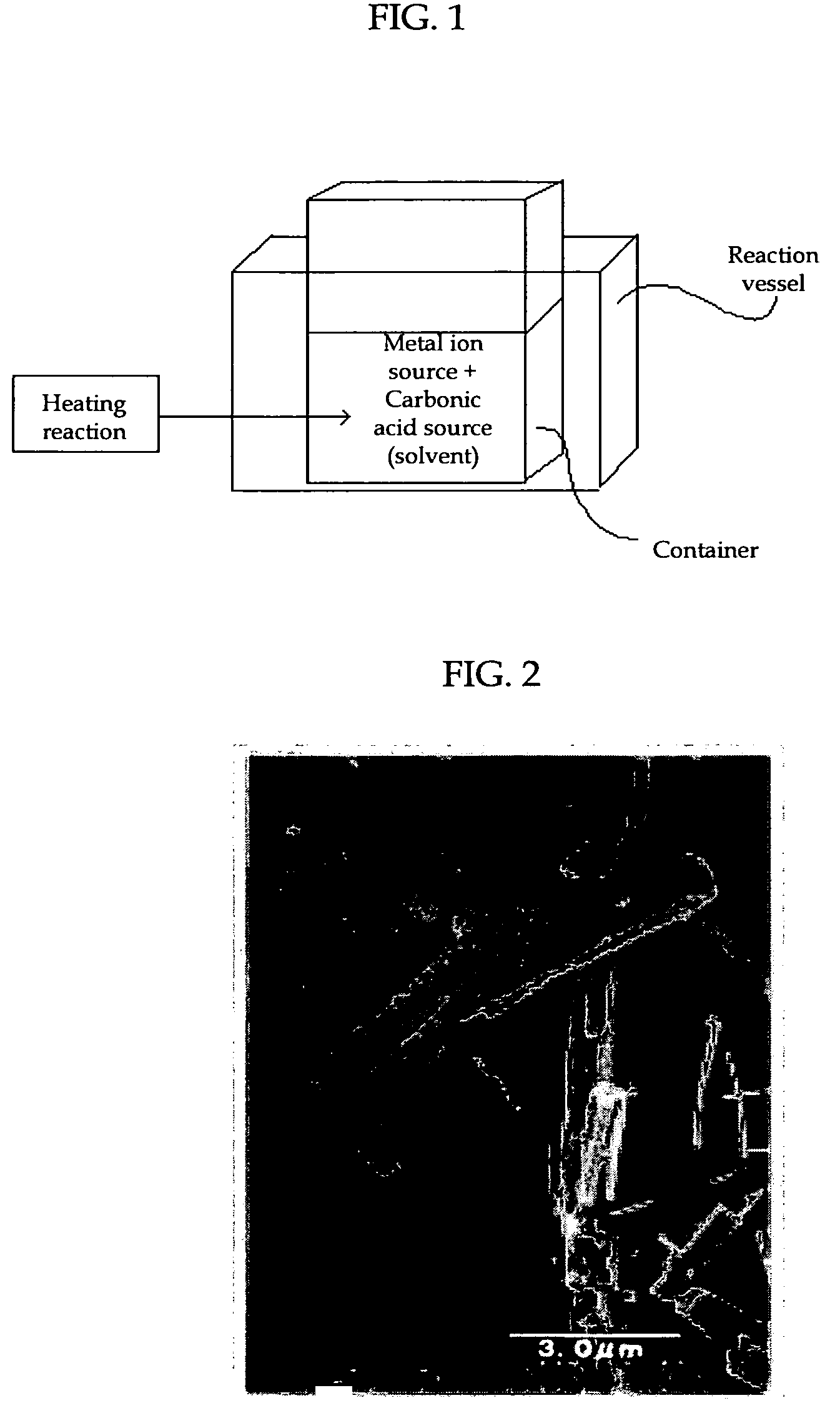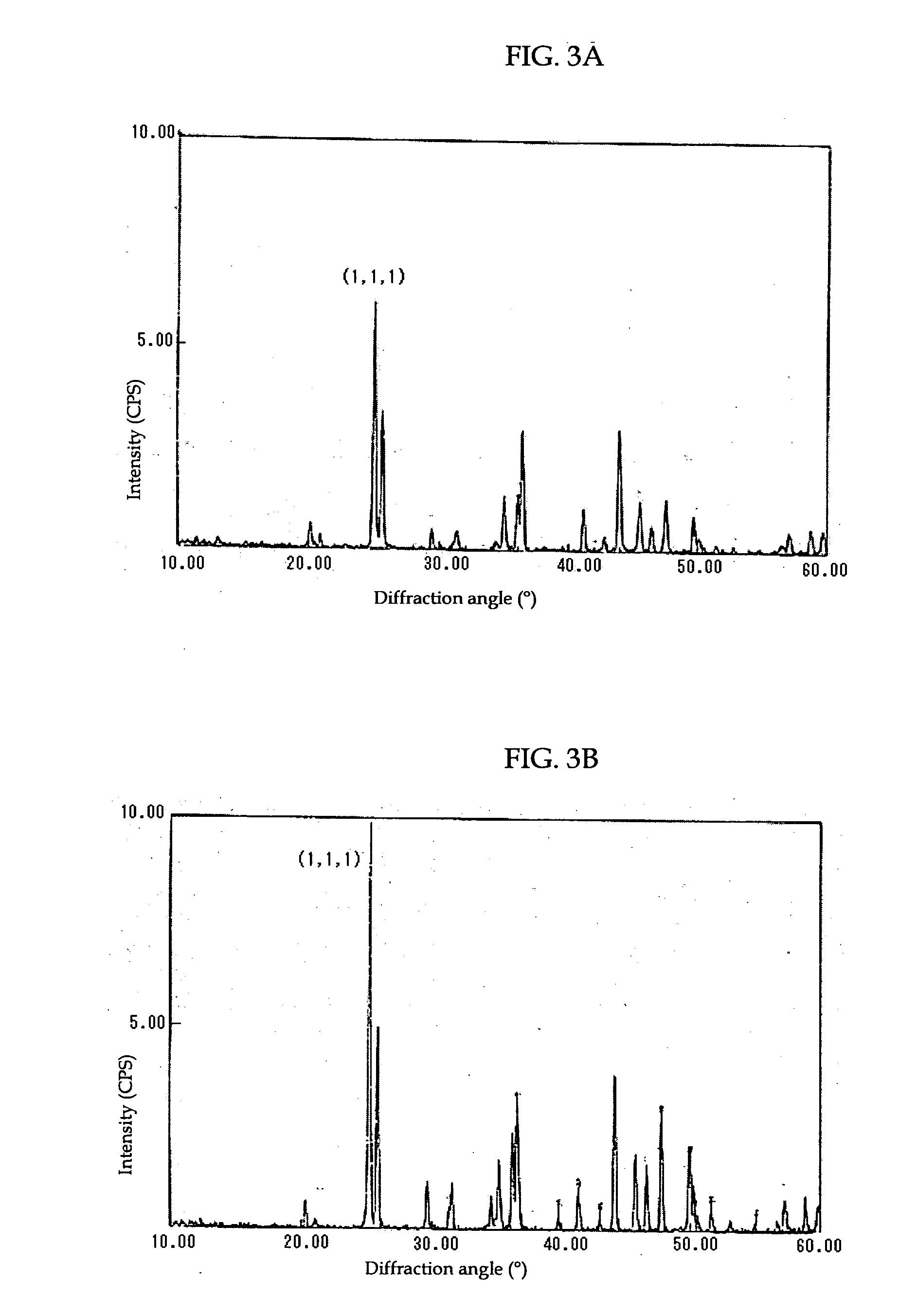Process for Producing Carbonate Particles
a carbonate and particle technology, applied in the field of carbonate particle production, can solve the problems of inability to produce carbonate particles with a desired size, inability to control the size of the material, serious problems in rewritable magneto optical discs, etc., and achieves the effects of less prone to rewritability, high crystallinity, and easy formation
- Summary
- Abstract
- Description
- Claims
- Application Information
AI Technical Summary
Benefits of technology
Problems solved by technology
Method used
Image
Examples
example 1
Preparation of Carbonate
[0066]As shown in FIG. 1, a strontium nitrate (Sr(NO3)2) solution as a metal ion source was mixed in a container with a urea ((NH2)2CO) aqueous solution as a carbonate ion source to prepare a mixture solution containing 0.33M strontium nitrate and 0.33M urea. The container having the mixture solution was then placed into a reaction vessel and held at 90° C. for 90 minutes while agitating the mixture, whereby thermal decomposition of urea occurred to produce strontium carbonate crystals as the foregoing carbonate. The agitation was conducted at 500 rpm.
[0067]The strontium carbonate crystals thus produced were recovered by filtration and dried. The dried strontium carbonate crystals were observed using a scanning electron microscope (S-900 by Hitachi Ltd.). An SEM picture taken at this time is shown in FIG. 2. From this picture it was confirmed that strontium carbonate crystals were obtained that are less agglomerated, have pillar (rod) shapes, and have an aver...
example 2
Process for Producing Carbonate Particles
[0069]As shown in FIG. 1, a 0.025M strontium hydroxide (Sr(OH)2) suspension as a metal ion source was mixed in a container with a 0.5M urea ((NH2)2CO) aqueous solution as a carbonate ion source to prepare a mixture solution. The pH of the mixture solution was 12.60. The container having the mixture solution was placed into a reaction vessel and held at 90° C. for 120 minutes while agitating the mixture, whereby thermal decomposition of urea (heating reaction) occurred to produce strontium carbonate crystals as the foregoing carbonate particles. The pH of the liquid after heating reaction, measured at room temperature (25° C.), was reduced to 11.50. The agitation was conducted at 500 rpm.
[0070]The strontium carbonate crystals thus produced were recovered by filtration and dried. The dried strontium carbonate crystals were observed using a transmission electron microscope (JEM-1010 by JEOL Ltd.). A TEM picture taken at this time is shown in FIG...
example 3
Preparation of Carbonate Particles
[0071]Carbonate (calcium carbonate) crystals were produced in a manner similar to that described in Example 1, with a calcium chloride solution used as a metal ion source in stead of a strontium nitrate solution. The calcium carbonate crystals thus produced were observed using the SEM. The measurement results of various parameters are shown in Table 3.
PUM
| Property | Measurement | Unit |
|---|---|---|
| aspect ratio | aaaaa | aaaaa |
| particle size distribution | aaaaa | aaaaa |
| length | aaaaa | aaaaa |
Abstract
Description
Claims
Application Information
 Login to View More
Login to View More - R&D
- Intellectual Property
- Life Sciences
- Materials
- Tech Scout
- Unparalleled Data Quality
- Higher Quality Content
- 60% Fewer Hallucinations
Browse by: Latest US Patents, China's latest patents, Technical Efficacy Thesaurus, Application Domain, Technology Topic, Popular Technical Reports.
© 2025 PatSnap. All rights reserved.Legal|Privacy policy|Modern Slavery Act Transparency Statement|Sitemap|About US| Contact US: help@patsnap.com



